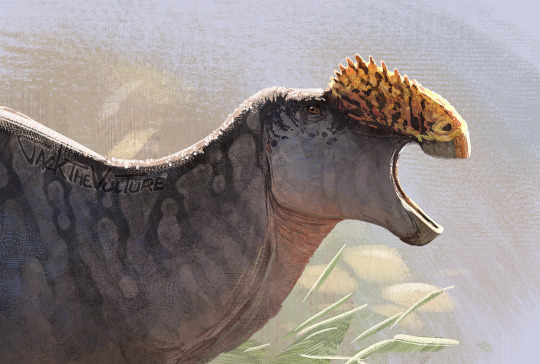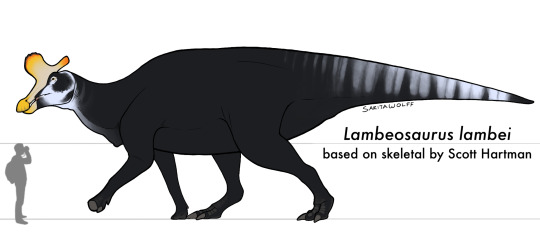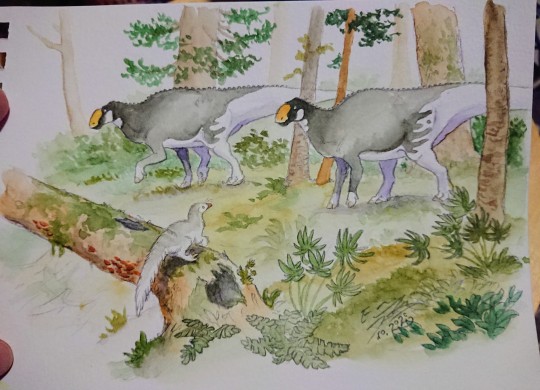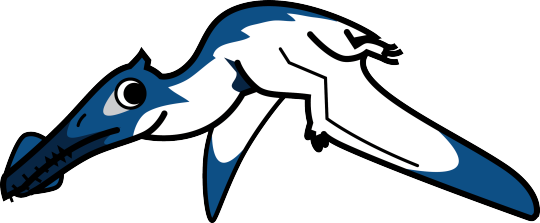#Gryposaurus
Photo

Gryposaurus showing off a speculative soft comb on his prominent nose! I totally missed that gryposaurus has evidence for midline scales. so pretend he has some.
1K notes
·
View notes
Note
Trick or treat!

Gryposaurus!
40 notes
·
View notes
Text

Gryposaurus
#paleoart#dinosaur#drawing#art#illustration#character#doodle#illust#digital art#palaeoblr#gryposaurus
676 notes
·
View notes
Text

Yes I draw dinosaurs when I’m stressed
This is a copy of a Gryposaurus painting by James Gurney (the dude who created the Dinotopia books)
#Inka’s art#dinosaur#I’m procrastinating by making little dinosaur drawings#at least I’m doing something#right?
8 notes
·
View notes
Text
Episode 26 of the Juras-Sick Park-Cast: "Control"
is now available on Youtube! Featuring excellent guest @Jordan_Mallon sharing about #tyrannosaurus #triceratops #spiclypeus lumping and splitting and naming new #dinosaurs!
youtube
#JurassicPark #MichaelCrichton

0:00 - Introduction Welcome to the Juras-Sick Park-Cast podcast, the Jurassic Park podcast about Michael Crichton's 1990 novel Jurassic Park, and also not about that, too.
Find the episode webpage at: Episode 26 - Control www.jurassickparkcast.blogspot.com/2022/08/episode-26-control.html
06:17 - Interview with special guest Dr. Jordan Mallon In this episode, my terrific guest Dr. Jordan Mallon returns to chat with me about: Tyrannosaurus imperator, T-regina, and T-rex, amorphous reptile bones, lumping and splitting, species diversity, extinctions, Triceratops trivia, big dinosaurs in Late Cretaceous North America, the bias in the fossil record towards large dinosaurs, naming dinosaurs like Spiclypeus, dinosaur names based on the Jurassic Park film, dinosaurs named in honour of Michael Crichton, dino-mania, styracosterna v. ankylopollexa, comparative anatomy, hadrosaurs v. saurolphines, synonymizing dinosaur names, Gryposaurus, Edmontosaurus v . Ugrunaaluk, phylogenetic mapping, why DNA doesn't preserve (hint, it's water!), and more!
15:00 - Why lumping and splitting different species of dinosaurs?
18:10 - The coolest things about triceratops!
29:15 - Naming dinosaurs, and dinosaurs named after Jurassic Park.
Plus dinosaur news about:
01:25 - Tyrannosaurus imperator, Tyrannosaurus regina and T. rex! Insufficient Evidence for Multiple Species of Tyrannosaurus in the Latest Cretaceous of North America: A Comment on “The Tyrant Lizard King, Queen and Emperor: Multiple Lines of Morphological and Stratigraphic Evidence Support Subtle Evolution and Probable Speciation Within the North American Genus Tyrannosaurus”
03:48 - A specimen-level phylogenetic analysis and taxonomicrevision of Diplodocidae (Dinosauria, Sauropoda)
0:33 - Featuring the music of Snale www.snalerock.bandcamp.com/releases
Intro: Supergroovy. Outro: T-Shirts.
The Text: This week’s text is Control, spanning from pages 126 - 133.
01:00:16 - A synopsis of the chapter Control in Jurassic Park Synopsis: As Jurassic Park’s employees conclude their demonstration of all their systems of control, Grant and Malcolm find themselves uneasy with the park’s approach to controlling living, breathing animals in an artificial setting, which is aiming to recreate a natural park setting.
01:06:33 - Analyzing the literary and stylistic techniques
01:13:12 - Discussions surround The Illusion of Control, dinosaurs, Version 4.4, Control is a hoax, Timeline and the God Complex Discussions surround: The Dinosaurs, Version 4.4, Control is a Hoax, the Timeline, and the God Complex.
Side effects: May cause animals like the Gila monster and rattlesnake to share their hemotoxins.
Thank you! The Jura-Sick Park-cast is a part of the Spring Chickens banner of amateur intellectual properties including the Spring Chickens funny pages, Tomb of the Undead graphic novel, the Second Lapse graphic novelettes, The Infantry, and the worst of it all, the King St. Capers. You can find links to all that baggage in the show notes, or by visiting the schickens.blogpost.com or finding us on Facebook, at Facebook.com/SpringChickenCapers or me, I’m on twitter at @RogersRyan22 or email me at ryansrogers-at-gmail.com. Thank you, dearly, for tuning in to the Juras-Sick Park-Cast, the Jurassic Park podcast where we talk about the novel Jurassic Park, and also not that, too. Until next time! #JurassicPark #MichaelCrichton
#Jurassic Park#Michael Crichton#Tyrannosaurus#Triceratops#dinosaurs#novels#podcasts#spiclypeus#paleontology#museums#skeletons#Youtube
3 notes
·
View notes
Text


#Archovember Day 13 - Lambeosaurus lambei
Lambeosaurus was a hadrosaurid from Late Cretaceous North America, and was very similar to the slightly older Corythosaurus in all ways but one: its strange head crest. The crest shifts forward rather than backward, and was filled with vertically stacked nasal passages which it would have used to amplify its calls. On L. lambei specifically, the crest also sported a large backward pointing “handle” to its “hatchet blade” head. Multiple skulls have been found which indicate sexual dimorphism (females had shorter, rounder crests) and an ontogeny where young Lambeosaurs would have grown their crests over time.
Like other hadrosaurs, Lambeosaurus could walk both quadrupedally and bipedally. It likely would have reared up on its hind limbs to reach the best leaves of the trees. But even on four legs Lambeosaurus would have been able to browse from the tops of many trees. It was a very large hadrosaurid, estimated to be between 7–7.7 m (23–25 ft) in length and 2.5–3.3 metric tons (2.8–3.6 short tons). Lambeosaurus lambei is also one of the hadrosaurids for which we have skin impressions, showing impressions of thin, scaled skin with small, scattered polygonal scutes on its neck, torso, and tail.
Both species of Lambeosaurus are known from the diverse Dinosaur Park Formation. It would have lived alongside other hadrosaurids like Prosaurolophus, Gryposaurus, and Parasaurolophus, ceratopsians like Centrosaurus, Styracosaurus, and Chasmosaurus, ankylosaurs like Edmontonia and Euoplocephalus, and the giant azhdarchid Cryodrakon. Its main predator would have been the tyrannosaurid Gorgosaurus.
#i know it’s late but I did get it on instagram on time so there#i just had absolutely no time to finish it until my lunchbreak at work today#my art#Lambeosaurus#Lambeosaurus lambei#once again I will tag the rest later I am just way too tired and I still have to draw tomorrow’s creacher
18 notes
·
View notes
Text
My big idea for Genie Team Season 10
Well, this is my 500th post, so I thought I’d talk about something big. That being one big idea I have for Grantgfan’s Genie Team season 10.
With that being the 10th season, I thought that my idea for it would be pretty big too. And my idea for The Genie Team season 10 is… the genies, their masters, and their friends finding out the realization of dinosaurs (and other prehistoric creatures) all around the world.
And this whole thing would be teased at the end of season 9, where a large map of the world with thumbtacks stuck in it, with each one depicting a known location of dinosaur sightings. They’d be 14 in all (at the moment); with 5 in North America, 3 in South America, 4 in Africa, 1 in Indonesia, and 1 in Australia. And as season 10 progresses, more thumbtacks would be added to the map, with a different color representing a different wave; like red for wave 1, blue for wave 2, green for wave 3, and yellow for wave 4.
And speaking of waves, the dinosaurs and other prehistoric creatures would make appearances in the several waves below.
WAVE 1: Dryosaurus, Gallimimus, Homalocephale, Kentrosaurus, Pachycephalosaurus, Styracosaurus, Ankylosaurus, Brachiosaurus, Camarasaurus, Corythosaurus, Edmontosaurus, Ouranosaurus, Parasaurolophus, Stegosaurus, Albertosaurus, Ceratosaurus, Dilophosaurus, Velociraptor, Acrocanthosaururs, Allosaurus, Spinosaurus, Tyrannosaurs Rex, Triceratops, Torosaurus, Carcharadontosaurus, Alioramus, Apatosaurus, Baryonyx, Compsognathus, Deinonychus, Diplodocus, Iguanodon, Maiasaura, Ornithomimus, Panoplosaurus, Tenontosaurus, Thescelosaurus, Wuerosaurus, Yangchuanosaurus, Pteranodon, Dimorphodon, Mosasaurus, and Tylosaurus.
WAVE 2: Othnielia, Hypsilophodon, Mamenchisaurus, Supersaurus, Brontosaurus, Ultrasaurus, Lambeosaurus, Shantungosaurus, Anatotitan, Olorotitan, Tsintaosaurus, Saurolophus, Hadrosaurus, Altirhinus, Centrosaurus, Einiosaurus, Pentaceratops, Euoplocephalus, Protoceratops, Psittacosaurus, Avaceratops, Microceratus, Orodrmeus, Gastonia, Edmontonia, Altirhinus, Brachylophosaurus, Gryposaurus, Hoplitosaurus, Stegoceras, Prenocephale, Tuojiangosaurus, Lexovisaurus, Paranthodon, Miragaia, Struthiomimus, Troodon, Proceratosaurus, Herrerasaurus, Torvosaurus, Tarbosaurus, Carnotaurus, Majungasaurus, Desplatosaurus, Suchomimus, Irritator, Procompsognathus, Ornitholestes, Cearadactylus, Geosternbergia, Nyctosaurus, Elasmosaurus, Plesiosaurus, and Styxosaurus.
WAVE 3: Dreadnoughtus, Alamosaurus, Argentinosaurus, Paralititan, Patagotitan, Sauroposeidon, Puertasaurus, Therizinosaurus, Convolosaurus, Leaellynasaurua, Stenopelix, Garudimimus, Wannanosaurus, Parkosaurus, Nipposaurus, Callovosaurus, Segnosaurus, Deinocheirus, Leptoceratops, Plateosaurus, Mussaurus, Melanosaurus, Oviraptor, Gigantoraptor, Caudipteryx, Lesothosaurus, Camptosaurus, Camposaurus, Yutyrannus, Rugops, Utahraptor, Dakotaraptor, Austroraptor, Sinosauropteryx, Mapusaurus, Tyrannotitan, Giganotosaurus, Gorogasaurus, Chirostenotes, Sinraptor, Microraptor, Sinornithosaurus, Archaeopteryx, Epidexipteryx, Caelestiventus, Tupuxuara, Zhenyuanopterus, Tropeognathus, Ornithocheirus, Hatzegopteryx, Alanqa, Hainosaurus, Icthyosaurus, Dakosaurus, Pliosaurus, and Temnodontasaurus.
WAVE 4: Shunosaurus, Saltasaurus, Nigersaurus, Amaragasaurus, Sinoceratops, Nasutoceratops, Agujaceratops, Chasmosaurus, Chungkingosaurus, Gigantspinosaurus, Dravidosaurus, Nodosaurus, Sauropelta, Minmi, Muttaburrasaurus, Dracorex, Stygimoloch, Dromiceimimus, Coelophysis, Eoraptor, Syntasaurus, Staurikosaurus, Saltopus, Shamosaurus, Struthiosaurus, Masiakasaurus, Eustreptospobdylus, Monolophosaurus, Limnoscelis, Labyrinthodontia, Diplocaulus, Koolosuchus, Metriorhynchus, Microposaurus, Sarcosuchus, Deinosuchus, Ichthyostega, Eogyrinus, Cacops, Seymouria, Prinoshuchus, Acanthostega, Eryops, Mastodonsaurus, Metoposaurus, Nothosaurus, Tanystropheus, Mesosaurus, Cryptoclidus, Kronosaurus, Liopleurodon, Shonisaurus, Onchopristus, Protostega, Archelon, Globidens, Ramphorhyncus, Ludodactylus, Scaphognathus, Tupandactylus, Azdarcho, Anomalocaris, Hallucigenia, Pterygotus, Ammonite, Cladoselache, Dunkleosteus, Eustenopteron, Hylonomus, Dimetrodon, Scutosaurus, Kannemeyeria, and Lystrosaurus.
That’s the four main waves of dinosaurs, pterosaurs, marine reptiles, and other prehistoric creatures that’ll appear in Genie Team season 10. It’s a lot of species, I know, but it’ll help in making season 10 of Grantgfan’s Genie Team even bigger. And I’d gladly help him in figuring out the scripts for future episodes of season 10.
2 notes
·
View notes
Text
Unreal And Innovative Facts About Gryposaurus Fossils
Gryposaurus, meaning "hooked-nosed lizard," was a fascinating genus of duck-billed dinosaur that roamed North America during the Late Cretaceous period, about 80 to 75 million years ago. Gryposaurus Fossils have been found in the Dinosaur Park Formation in Alberta, Canada, as well as in the Lower Two Medicine Formation in Montana and the Kaiparowits Formation of Utah in the United States. Read More https://www.fossilageminerals.com/blogs/news/unreal-and-innovative-facts-about-gryposaurus-fossils

0 notes
Text
Vocabulary (pt.mxcvii)
Words taken from Children’s Encyclopedia of Rocks and Fossils (2019) by Claudia Martin:
Andes
a major mountain system running the length of the Pacific coast of South America. It extends over some 8,000 km, with a continuous height of more than 3,000 m.
Burgess Shale (n.)
a block of shale in Yoho National Park, British Columbia, unique in having fossil remains of over 140 invertebrate species.
Carpathian Mountains
a mountain system extending southeastward from south Poland and Slovakia into Ukraine and Romania.
Gryposaurus (n.)
a genus of duckbilled dinosaur that lived about 80 to 75 million years ago, in the Late Cretaceous (late Santonian to late Campanian stages) of North America. [x]
Laetoli
a well-known palaeontological locality in northern Tanzania whose outstanding record includes the earliest hominin footprints in the world (3.66 million years old), discovered in 1978 at Site G and attributed to Australopithecus afarensis. [x]
Myanmar
the official name (since 1989) for Burma.
oolite (n.)
a sedimentary rock, usually limestone, consisting of rounded grains made up of concentric layers.
Placenticeras (n.)
a genus of ammonites from the Late Cretaceous. [x]
splodge (n.)
British informal. = splotch.
Vanuatu
a country consisting of a group of islands in the southwest Pacific; capital: Vila. Formerly called the New Hebrides.
#av#avdictionary#vocabulary#english vocabulary#Children’s Encyclopedia of Rocks and Fossils#claudia martin
0 notes
Note
Gigantosaurus, Mapusaurus, psittacosaurus, lambeosaurus, ouranosaurus, Kentrosaurus, Ninjatitan, albertosaurus, Dasplatosaurus, Rajasaurus, Protoceratops, Nodosaurus, Citipati, Oviraptor, Gryposaurus, Guanlong, Mononkyus, Pachycephalosaurus, Ornithomimus, Stigymoloch, Carnotaurus, Gojirasaurus, Eoraptor, Plateosaurus, Tarbosaurus, Yutyrannus, Gorgosaurus, Compsognathus, Baryonyx, Corythosaurus
.
1 note
·
View note
Video
Gryposaurus
by Orin Zebest
79 notes
·
View notes
Text
Note One: Thescelosaurids may or may not be Ornithopods
Note two: the listed members are examples and there are usually many more genera in a given group
#ornithopod poll#palaeoblr#dinosaurs#ornithopods#polls#hadrosaurs#parasaurolophus#maiasaura#iguanodon#tenontosaurus#thescelosaurus#et cetera
128 notes
·
View notes
Text


Encounter in the woods.
Stonemaker meeting couple of white tailed bellowers.
92 notes
·
View notes
Photo

Gryposaurus
Instagram| Redbubble
90 notes
·
View notes
Text
Mesozoic Monthly: Gryposaurus

The Late Cretaceous-aged (~75 million-year-old) large-nosed North American hadrosaur (aka duck-billed dinosaur) Gryposaurus by ginjaraptor on DeviantArt.
Anyone who frequents the Pittsburgh area is familiar with ‘Pittsburghese,’ the regional dialect given full voice in what was once voted America’s ugliest accent (a fact that does not diminish our pride for it). One of my personal favorite Pittsburghese words is “nebby,” which translates to “nosy” for any non-local readers. “Nebby” can be used in a variety of contexts: the distant relative asking prying questions about your love life at Thanksgiving dinner is nebby, the pet cat trying to crawl under the bathroom door to see what you’re doing is nebby, and even the statue of Carnegie Museum of Natural History mascot Dippy the Diplodocus, silently judging your driving on Forbes Avenue, is nebby. We can assume other dinosaurs were nebby too, since so many had huge noses to stick into things. One of the biggest noses in the fossil record belongs to Gryposaurus notabilis, the star of this edition of Mesozoic Monthly.
Gryposaurus belongs to a group of dinosaurs called hadrosaurs, which are commonly referred to as duck-billed dinosaurs. Hadrosaurs were herbivores that got their nickname from the flat, toothless, somewhat duck-like beaks at the tips of their jaws. These beaks were used to bite through tough vegetation so that it could be ground up by the numerous teeth embedded in the rear half of the jaws. There are two main groups of hadrosaurs, both of which are featured in CMNH’s Dinosaurs in Their Time exhibition. Probably the more famous group is the Lambeosaurinae, known for their distinctive head crests that housed extra-long nasal passages. Virtually everyone can recognize the incredible backward-curving crest of Parasaurolophus (featured multiple times in the Jurassic Park franchise), and visitors to CMNH will also know the helmet-like crest of Corythosaurus. The second group is the Saurolophinae (traditionally known as the Hadrosaurinae), which typically lack bony crests. You can find a simulated carcass of the saurolophine Edmontosaurus (lovingly known to those of us in CMNH’s Section of Vertebrate Paleontology as “Dead Ed”) between the two imposing Tyrannosaurus skeletons in Dinosaurs in Their Time.

A gallery of hadrosaur heads. Top left: the lambeosaurine Parasaurolophus at the Field Museum of Natural History in Chicago (photo by the author). Top right: the lambeosaurine Corythosaurus at Carnegie Museum of Natural History (photo from Wikimedia Commons). Bottom left: the saurolophine Edmontosaurus at the Houston Museum of Natural Science (photo from Wikimedia Commons). Bottom right: the saurolophine Gryposaurus at the Natural History Museum of Utah in Salt Lake City (photo from Wikimedia Commons).
As a crestless hadrosaur, Gryposaurus was a saurolophine. Despite its lack of crest, its skull still had pizzazz: its nasal bone arched dramatically, giving the impression of a ‘Roman nose’ (which is very noticeable if you compare the skulls of Edmontosaurus and Gryposaurus in the image above). The name Gryposaurus notabilis means “notable hooked-nose lizard” in homage to this feature. G. notabilis is the type species of Gryposaurus; type species are typically the first ones to be named in a genus, and therefore become the reference to which all new specimens that may belong to that genus are compared. The other species (such as G. monumentensis, shown in the photo montage above) are similar enough to the type species that they can be referred to the genus Gryposaurus, but they differ in too many ways to be assigned to G. notabilis itself.
Occasionally, paleontologists will revisit a fossil species or genus and decide that it is either too similar to another to justify its own name or that certain specimens are too different to be grouped under the same name. Kritosaurus, another saurolophine with a ‘Roman nose,’ has fallen victim to both of these circumstances. It was originally considered its own genus, but was subsequently revisited by paleontologists who decided that it was so similar to Gryposaurus that the two genera were lumped together under the name Gryposaurus (when combining taxonomic groups, the first name that was published is the one that gets used). However, later paleontologists reviewed the evidence again and split a single species of Kritosaurus back out of Gryposaurus. The famous sauropod (giant long-necked herbivorous dinosaur) Brontosaurus underwent a similar series of changes over the years: originally, it and Apatosaurus were considered different animals, but after a review they were lumped together under Apatosaurus. Recently, the two were split apart again and the name Brontosaurus was revived (to the delight of fans of that name around the world).
It is not uncommon in paleontology for species to be lumped or split based on new or revisited evidence. When you consider that the decision to name new fossil species is often based on fragmentary, highly incomplete skeletons, you can see why it might be difficult to get things right the first time! These changes sometimes give people the impression that paleontologists “can’t make up their minds” or “contradict themselves,” but we must remember two things. First, that science is meant to change based on new evidence. Second, there have been thousands of paleontologists over the course of history, and every one of them is an individual person who can draw their own conclusions based on the same evidence. Although the resulting changes can disappoint fans of a specific animal or hypothesis, revision is normal and beneficial for the field as a whole. Scientists are supposed to be nebby – it’s how we make new discoveries!
Lindsay Kastroll is a volunteer and paleontology student working in the Section of Vertebrate Paleontology at Carnegie Museum of Natural History. Museum staff, volunteers, and interns are encouraged to blog about their unique experiences and knowledge gained from working at the museum.
#Carnegie Museum of Natural History#Mesozoic Monthly#Gryposaurus#Cretaceous#Hadrosaur#Dinosaurs#Dinosaur
18 notes
·
View notes
Photo




Available on Redbubble!
gryposaurus, dsingaripterus, anhanguera, pterodaustro
#gryposaurus#dsingaripterus#anhanguera#pterodaustro#pterosaur#pterodactyl#hadrosaur#cute#sticker#redbubble#dinosaur#not a dinosaur#jurassic world#jurassic park
217 notes
·
View notes